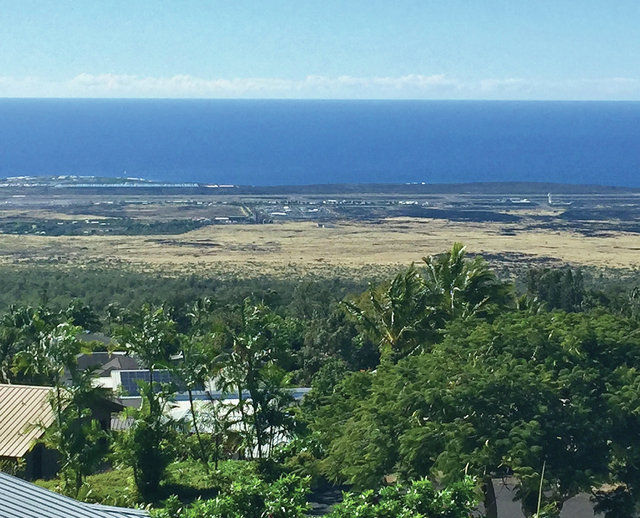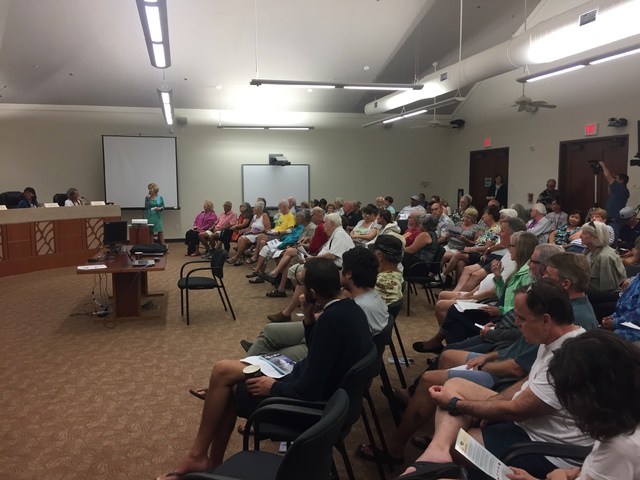KAILUA-KONA — Vog experts, health professionals and concerned citizens gathered in Kona for a seminar meant to answer one simple question: Is vog the greatest daily threat to the health of Hawaii Islanders?
In short, the answer is no, but presenters at the Community Enterprises Forum at the West Hawaii Civic Center Thursday night said the negative health consequences of too much vog exposure shouldn’t be taken lightly.
“I think that there’s a difference between looking at health impacts for a population and looking at health impacts for an individual,” said Tamar Elias, of the U.S. Geological Survey and the Hawaiian Volcano Observatory. “I think if you look at it on a population base, there seems to be a lot of things ahead of vog. But for certain individuals, who are (otherwise) pretty healthy, it might be their No. 1 health issue.”
Dr. Elizabeth Tam, of the University of Hawaii at Manoa’s John. A. Burns School of Medicine in Honolulu, agreed with Elias, comparing vog impacts with other forms of air pollution that are primarily man-made.
“For some people, they really are symptomatic, so I don’t want to discount that,” Tam said. “There’s a lot more information about the fossil fuels — the industrial and traffic related air pollution — and the environmental tobacco smoke, so you have to keep those things in mind as well.”
The source of vog across Hawaii Island is the Kilauea volcano. Its emissions are comprised primarily of water vapor, carbon dioxide and sulfur dioxide (SO2). The SO2 eventually converts to fine particles after interaction with elements present in earth’s atmosphere. These particles scatter sunlight and create the sometimes dense haze referred to as vog.
Elias explained that the USGS started measuring SO2 gas in 1979, registering the first notable jump in order of magnitude in 1983. Emissions were less frequent then, and natural wind patterns cleared the air with relative ease.
In 1986, emissions became more continuous and the first real impacts of vog were observed on Hawaii Island. The most recent hike in emissions was registered in 2008, when the summit eruption began, marking the greatest documented concentration of SO2 on the island, Elias explained.
Emissions have curbed in the last several years, but Elias said there’s still a significant amount of gas present in the air on a regular basis. The shift of the primary emissions source to the summit from the east rift in 2008 also changed which areas of the island were most impacted by vog.
“These communities that are directly downwind — Pahala, Ocean View — these places had much more impact once the focus of gas release changed,” Elias said.
She added the Kailua-Kona area has only exceeded the acceptable health standards of particulate matter pollution on a couple of days since 2010, although health impacts can still be observed there.
Those impacts are among the consequences of vog that go well beyond decreased visibility and obstructed views of Hawaii Island’s natural beauty.
According to the Hawaii Interagency Vog Dashboard website — recommended Thursday night by John Peard of the Hawaii Department of Health as the best available source for comprehensive vog information — there are both short-term and long-term impacts of vog that exacerbate existing conditions or create symptoms in otherwise healthy individuals.
Symptoms can include everything from irritation of the eyes, nose, throat and skin to coughing to chest tightness and shortness of breath. Others have suffered from fatigue or dizziness, and the website also says those exposed to vog may become more susceptible to respiratory conditions.
“Both long-(term) and short-term particle exposures have been linked to various health problems,” the website reads. “High levels of particle pollution are linked to increased hospital admissions and emergency room visits, and even to death from existing heart or lung disease.”
The demographics defined as “sensitive groups” include the elderly, expecting mothers and children, particularly newborns. Those who suffer from cardiovascular disease, asthma or other respiratory issues are also more prone to experience health impacts from vog emissions.
Peard said the best way to protect one’s self from vog is to utilize the vog dashboard website to monitor closely air conditions and weather patterns in areas where one lives or plans to spend extended periods of time. The dashboard is accessible at ivhhn.org/vog/content/vog-information-portal.
Remaining indoors during heavy periods of vog and limiting physical activity should reduce any present or potential symptoms of vog exposure, Peard added.
A final, and perhaps less well-known, consequence of vog on Hawaii Island is acid rain, which Elias said is of particular concern to residents living in older homes and using water catchment systems.
“Rainfall in Hawaii in general is slightly acidic,” Elias explained. “Early on in the eruption, it was found that some of the people who were on water catchment, particularly in South Kona, had elevated levels of lead and copper in their cisterns. That was from the acidity of the rain leaching the lead from the building and plumbing materials. So the older homes that had those lead-headed roofing nails and also old solder (were most affected).”
Elias added that older homes still may still be susceptible to lead leaching by way of acid rain, even though the HDOH took several steps to alleviate the problem once it was first discovered.
She said there is a program offered by the HDOH that allows for a subsidized water test every year for homes reliant on water catchment.

















